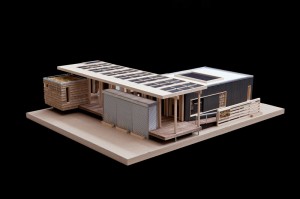Solar Decathlon Team Using Appalachian Mountain History To Model Home of the Future
Monday, April 4, 2011By April Saylor
Editor’s Note: This entry has been cross-posted from DOE’s Energy Blog.
In honor of the U.S. Department of Energy Solar Decathlon—which challenges 20 collegiate teams to design, build, and operate solar-powered houses that are cost-effective, energy-efficient, and attractive—we are profiling each of the 20 teams participating in the competition.
For our second profile, we spoke with Appalachian State University’s faculty advisors Jamie Russell and Chad Everhart about The Solar Homestead, their team’s entry into the competition. Both Chad and Jamie are professors from the university’s building science program in the Department of Technology. Chad provided guidance for the architecture and design portions of the project, while Jamie helped with the engineering side of things.
Chad told us that the original idea for The Solar Homestead was created in the fall of 2009 by a group of eight graduate students that put together a design proposal for entry into the decathlon. The team, he says, was inspired by the pioneer spirit of the early settlers in the mountain region of North Carolina near the school’s current location.
“We had the students actually go out into the region and research the old homesteads. Those old farms all had sustainable characteristics in common that created a passive solar strategy like what we use today: they all faced south, and all had deciduous trees planted next to the house to provide shade in the summer and sun in the winter.”
“We took the self-sufficiency principles of those early frontiersmen and homesteaders and, based on the precedents we found in old homesteads still standing in the region, tried to created a modern way of life that incorporated new building standards.”

Appalachian State University’s Solar Homestead conceptual model (Credit: All Commercial Photography/U.S. Department of Energy Solar Decathlon)
From that original proposal, the team has designed a high-performance house that uses independent, technologically advanced “outbuilding modules” that function as standalone solar collection sites. The design of these outbuilding modules was inspired by traditional lean-to sheds found on the original Appalachian homesteads, and they supply power and heat to the house.
Jamie told us that the outbuildings are meant to function as a modern equivalent of various traditional outbuildings and collect sunlight and deliver a flow of renewable energy. The outbuildings are designed to have the flexibility to act as porch, outdoor kitchen, guest room, carport, or storage shed. The Solar Homestead has incorporated the outbuildings into a home office and a “Great Porch” that the team says is reminiscent of the front porch lifestyle of the early Appalachian settlers.
In addition to the faculty advisors, The Solar Homestead team is composed of 50 full time students who work on the project in various classes in colleges throughout the university and more than 100 volunteers. Since receiving their $100,000 from the Department of Energy, the team has raised an additional $600,000 from outside donors and the university so that students can afford to dedicate the time necessary for a project of this magnitude.
“We noticed the students were dropping out of the program because they didn’t have time to work at their outside jobs, and so we’ve been raising the extra money so that we can use that original $100,000 to pay the kids for the work they do outside of class hours,” Jamie told us.
“We’ve been lucky to have this much support,” Jamie said.
Both of the assistant professors said working on The Solar Homestead has really inspired them. “We’ve been able to see the dedication and excitement of the students and watch that grow in each student,” Jamie told us. “It’s renewed my excitement for being a teacher. These students have not only met expectations but really exceeded them and in turn have re-energized us.”
For more information about The Solar Homestead, visit its Web site or blog.
April Saylor is an online content producer and contractor to the U.S. Department of Energy’s Office of Public Affairs.
Tags: Appalachian State, Solar Decathlon, Solar Decathlon 2011, Teams
